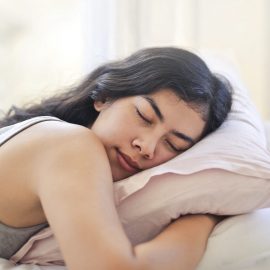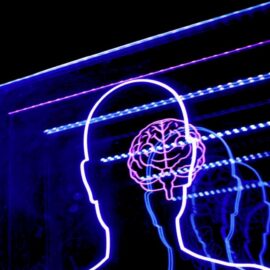

This article is an excerpt from the Shortform book guide to "Glucose Revolution" by Jessie Inchauspé. Shortform has the world's best summaries and analyses of books you should be reading.
Like this article? Sign up for a free trial here.
Do you often get hungry soon after eating? Do you feel tired and out of sorts throughout the day?
If your answer is yes, you may be experiencing glucose spikes. Luckily, the solution to this problem is simple, and you don’t have to give up anything you like to eat. According to biochemist Jessie Inchauspé, you can prevent glucose spikes and ensuing tiredness by simply changing how you eat your food.
Here are some tips on how to prevent blood sugar spikes so you don’t crash in the middle of the day.
#1: Eat Fiber First
Inchauspé’s first piece of advice on how to prevent blood sugar spikes is to simply change the order in which you eat your food. Start your meal with fiber, then eat proteins and fats, and finish with starchy and sweet carbohydrates.
Studies indicate that this eating order is as successful at preventing glucose spikes as diabetes medications targeted toward the same issue.
According to Inchauspé, you should eat fiber first because it prevents glucose from being absorbed into your bloodstream too quickly, thus preventing harmful spikes. Fiber accomplishes this in three ways. First, it slows the activity of the enzyme alpha-amylase. As a result, your body breaks down starch into glucose more slowly.
Second, fiber reduces the speed at which your stomach contents empty into your intestines. Glucose is absorbed into the bloodstream through your intestines, so this slowing effect ensures that you won’t get too much too quickly.
Finally, fiber creates a permeable barrier in your small intestine that makes it harder for glucose to pass through it into the bloodstream, preventing too many molecules from entering at once. (Shortform note: Studies suggest that a lack of dietary fiber leads to the thinning of the intestinal lining, which makes your intestines more permeable. This has implications beyond quick glucose absorption—a too-permeable gut lining can have negative effects on your immune health and leave your gut vulnerable to pathogens.)
Inchauspé suggests making a vegetable dish the first course of every meal, so you never forget to start with fiber. (Shortform note: If creating vegetable dishes for every meal sounds intimidating, consider looking online for high-fiber recipes that can serve as starters. For example, NYT Cooking has a whole page devoted to high-fiber dishes, and the Mayo Clinic has a list of high-fiber recipes organized by category.)
#2: Eat Fats and Proteins Second
Inchauspé expands on her advice, stating that eating fats and proteins second further amplifies the beneficial effects of lowered glucose spikes—fats and proteins also prevent the stomach from emptying too quickly, thus blocking rapid glucose absorption. You can still eat sweet foods and starches during your meal if you want, but they won’t have such a negative effect if you eat them last.
(Shortform note: In addition to slowing digestion, fats and proteins make us feel full for longer. Fats are the last macronutrient to leave our digestive tract, so they play an important role in making us feel satiated. Just like it’s better to eat unprocessed carbs, it’s best to eat whole, unprocessed fats like avocados, nut butter, and olive oil. Further, studies suggest that peptides, the digested versions of dietary proteins, block certain chemicals in nerve cells that make us want to eat more. By curbing our appetites, this prevents us from eating too much. If we’ve eaten proteins and fats before carbs, these feelings of fullness will make us less likely to overindulge in glucose-heavy foods.)
Alternatively, if you eat your starchy and sugary carbs first, they move swiftly to your small intestine, and there’s nothing to slow their breakdown into glucose molecules. The glucose enters your bloodstream in a large, quick influx, causing a spike. (Shortform note: Not all carbs enter your bloodstream at the same rate. The speed at which you digest and absorb a carb is called its glycemic response. Foods with high glycemic responses break down quickly, while foods with low glycemic responses enter the bloodstream slowly and steadily.)
#3: Avoid Eating Carbs by Themselves
Inchauspé acknowledges that it isn’t always possible to eat the food types separately and in the right order—sometimes, you’re in a rush and can’t plan a balanced meal. Other times, you might be eating a dish that contains all the food types at once, like soup. (Shortform note: If you want to create healthy, balanced meals that require low effort, you could try one-pot recipes that combine all your macronutrients (proteins, fats, fiber, and carbohydrates). Nutritionally well-rounded meals usually include a mix of protein, healthy fats, and complex carbohydrates.)
In these cases, Inchauspé suggests always accompanying carbs with one of the other food types to still prevent the quick absorption of glucose. For example, if you’re having an apple, eat it with unsweetened peanut butter so the fat and protein help prevent a glucose spike from the sweet fruit.
(Shortform note: Some people practice food combining diets, meaning they believe certain types of food shouldn’t be eaten together. This contrasts with Inchauspé’s advice to always combine carbs with another food type. Proponents of food combining diets think eating the wrong combinations of food can lead to disease, poor digestion, and increased toxins in the body. For example, some believe that proteins and carbs should never be eaten together, and dairy products should only be consumed on an empty stomach. There’s very little science to support these food combining beliefs, however, and most of them derive from ideas that are over 100 years old. In contrast, there’s ample evidence to support Inchauspé’s opposite claims.)
#4: Exercise After Eating
According to Inchauspé, you can also prevent glucose spikes by changing what you do after you eat—specifically, by exercising. When you move your muscles during exercise, they use an energy-providing molecule called ATP to contract. ATP is made from glucose in the mitochondria, so you burn glucose every time you exercise. Instead of letting glucose collect throughout your body and cause a spike, your muscles use it up.
The rate at which your body burns glucose depends on the type of activity you’re doing. The more your muscles contract, the more glucose and energy they require. That being said, you don’t have to do intense exercise to achieve these benefits. Even just taking a short walk after a meal can help.
| Different Kinds of ATP Some types of exercise are better for burning glucose because different kinds of ATP are made for physical activity of varying duration and intensity. Your body uses four different sources of ATP: A small amount of immediately available ATP is stored in your muscles, but this only lasts about three seconds. Once you’ve used up your ATP reserves, your muscles use a high-energy compound called creatine phosphate to rapidly synthesize ATP. This lasts for about eight to 10 seconds, and it’s good for short bursts of intense activity, like weight-lifting. Your muscles can also use their reserves of glycogen (the stored form of glucose) to make ATP quickly. This form of ATP is made more slowly than the kind that comes from creatine phosphate, but it’s still rapidly available, and it lasts for around 90 seconds. This kind of energy is good for exercise like longer sprints. By using up your glucose stores, this also makes room for more reserved glucose from the food you eat, reducing your risk of spikes. Finally, after about two minutes of exercise, your body provides your muscles with oxygen, which means that aerobic respiration can happen. Aerobic respiration is the process by which glucose is turned directly into ATP with the help of oxygen. The glucose used may come from remaining glucose in the muscle cells, the liver’s glycogen stores, glucose from food in the intestine, and fat reserves. This kind of ATP takes the longest to create, but it also lasts the longest—as long as there’s a supply of glucose to fuel it, your body can make more ATP. It’s good for longer forms of exercise, like long-distance running, rowing, and so on. ATP made through aerobic respiration helps control glucose spikes after eating by burning glucose from many sources throughout your body. Walking, which Inchauspé suggests doing after eating, is a great example of aerobic exercise that can trigger this process. |

———End of Preview———
Like what you just read? Read the rest of the world's best book summary and analysis of Jessie Inchauspé's "Glucose Revolution" at Shortform.
Here's what you'll find in our full Glucose Revolution summary:
- Why you feel hungry soon after you eat and get tired throughout the day
- The role glucose plays in your body, both positive and negative
- Strategies for taking control of your health and glucose levels






